Navigating Intersections - Visibility
Drivers and cyclists don't always understand the benefit of a cyclist navigating intersections using the middle or left hand side of the lane to improve the cyclist's visibility. Many bike education groups and professional studies suggest we should always position ourselves in the middle or left hand side of the lane, while others promote situational spacing based on the factors at play. While we understand that some cyclists do not feel comfortable "taking the lane", it is significantly safer to do so while navigating intersections. We have two short videos and six graphics to demonstrate proper lane positions in intersections.
Note: The Blue Box Diagrams were used with the written permission from Bike Walk NC.
INTERSECTION POSITIONING
Let's start with a quick video from the League of American Bicyclists that describes where you should be in the road while navigating intersections.
DRIVE OUT SITE LINES - 2 WAY STOP
The cyclist using the left hand side of the lane is much more visible to the car at the stop sign than the cyclist riding near the right curb. Drivers see things in their main field of vision quicker and the tree doesn't help either! The driver would be much more likely to roll though the stop sign if there was only one "hidden" cyclist riding next to the curb. This same concept applies to cars backing out of driveways that can't see cyclists on the sidewalk.
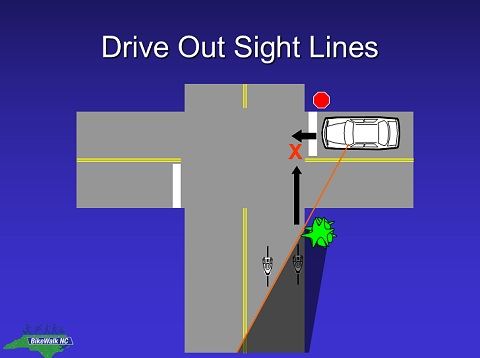
THE LEFT CROSS SIGHT LINES - 2 WAY STOP
While a great asset in the boxing ring, a left hook is dangerous to cyclists. This can happen when the driver doesn't see the cyclist or the driver thinks they have room to sneak by in front of you. When there is an extra obstacle like a car traveling in front of you, the approaching driver has a poor field of vision. The driver that is turning can see you much easier if you are positioned in the center or a little left of center of your lane.
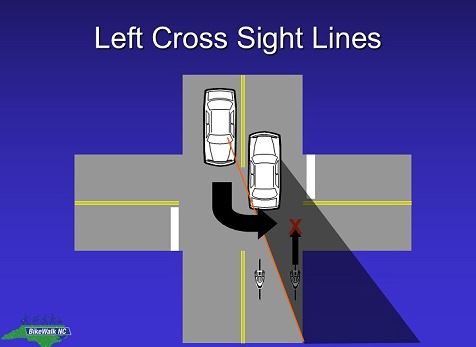
THE RIGHT HOOK COLLISION
You should position yourself in the middle of the lane or left of the middle so that you don't give the driver a chance to right hook you or others in your group. In this example the cyclist does not have a stop sign and the cross traffic has a stop sign. If you see a car behind you, move over to the middle of the lane or the left of the middle and take firm control of the lane. If you are hugging the curb, the car driver may be in hurry and think they can squeeze around you to save those extra seconds.
While not pictured, this can also happen happen at a four way stop. If you arrive at the intersection first, position yourself in the middle of the lane so that a car approaching from the back can't maneuver themselves ahead of you to make their right turn until after you have cleared the intersection. If the car arrives at the four way stop first, you should never slide up between the car and the curb. That is just inviting trouble and gives all cyclists a bad name and increases driver's dislike for cyclists. If you see someone in the Club using this maneuver, you should politely correct their behavior or notify the Ride Leader if you are hesitant to approach another rider.
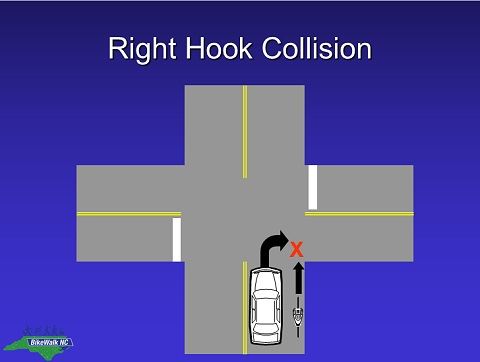
While this next video does not have stop signs, it is a good example of a driver right hooking a cyclist riding in the bike lane, or is that just a shoulder?
CURVE SIGHT LINE
While not an intersection example, the same concepts apply to visibility around a curve. A rider using the middle of the lane is much more visible to a car approaching from the rear around a bend in the road than a cyclist that is hugging the right curb.
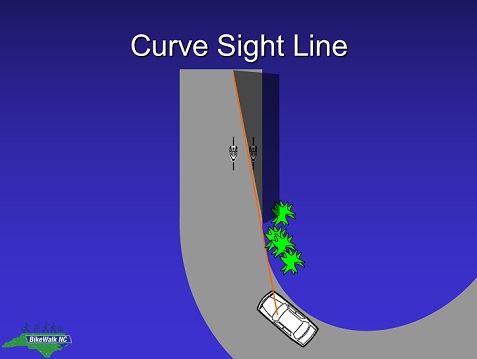
RIGHT HAND ONLY TURN LANES - TWO LAKE ROAD EXAMPLES
Wen we approach an intersection that has a right turn only lane, where should we position ourselves to go straight through the intersection? (I learned very early on from riding with Mark Kasmark how to properly navigate this situation.) You belong in the left hand straight through lane positioned in the middle of the lane. For example, that would be directly behind the white car in the first photo or the silver SUV in the second photo. After you clear the intersection, check for traffic and signal your intention to go back to the right hand side of the road. It is illegal for you to go straight in the right hand turn only lane. You are endangering yourself and maybe others that blindly follow you by using the wrong lane - you could easily get right hooked as the car driver behind you will assume that you are turning right because you are in the right turn only lane. You also will upset car drivers that could have otherwise legally turned right on red, but have to sit behind you impatiently until the light turns green and you clear the intersection.
Lake Road at Abbe Road headed East - with stoplight
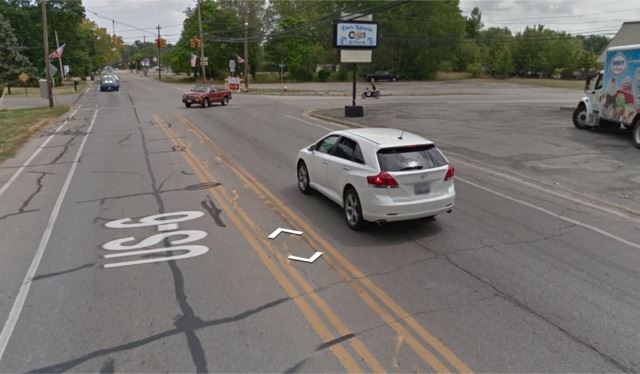
Lake Road at Miller Road headed East - without a stoplight
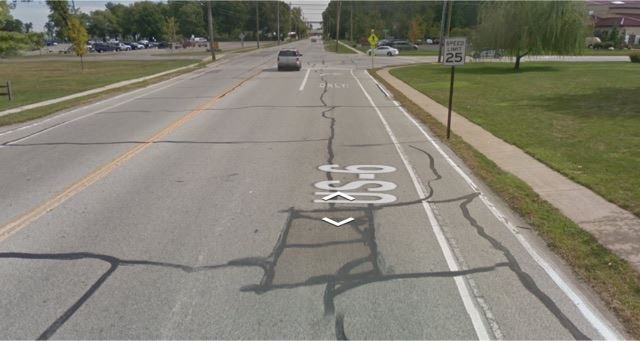
Summary & Practical Suggestions by Ed Stewart Why do car-bike collisions occur? Here are some major reasons. A. Motorist does not ‘see’ the bicyclist. A motorist might not see you, or be aware of your presence, because you are not in a good position. As you approach an intersection, move your bike more toward the center of the lane. If you intend to make a left turn, move your bike to the left side of the lane and make your hand signal obvious. If you are going straight, place your bike in the center of the lane and keep pedaling. Turning right? Stay in the right part of the lane - but never at the edge. Use right hand signal. If you can obtain eye contact with the motorist, you know he sees you. If no eye contact, keep pedaling and maybe wave to create a movable object presence. B. Motorist does not yield to bicyclist. If the motorist is not yielding and you are able to, just slow down and let him go. If you are into the intersection first, wave a friendly ‘thank you’ and proceed. If it looks as though things might get close, look for a ‘plan B’ escape route. C. Bicyclist does not yield to motorist. If you are not yielding the right of way to the motorist and horn blowing begins, try to gesture a “I’m sorry” or some other form of etiquette. If you have entered an intersection without stopping at a stop sign or red light, well.... We would hope any Silver Wheeler knows better than ignoring traffic signals. This was the short version. For a more complete discussion on this and many other safety topics, read with understanding the section on the club website called “Standards for Bicycle Safety” under Resources. One does not learn to change from unsafe biking to being a safe cyclist by reading a short article, looking at a photo or watching a video. You will not learn from other cyclists who do not know - or care about - the difference. If you want to be a safer cyclist you should ask for classes and rides designed to help you learn the nuances of bicycle safety. Bob Burkhardt, Larry Best and Mark Kasmark have been trained and certified to do this for you. You owe it to yourself to learn how to be a safer cyclist - your club is able to help you attain that goal. |
